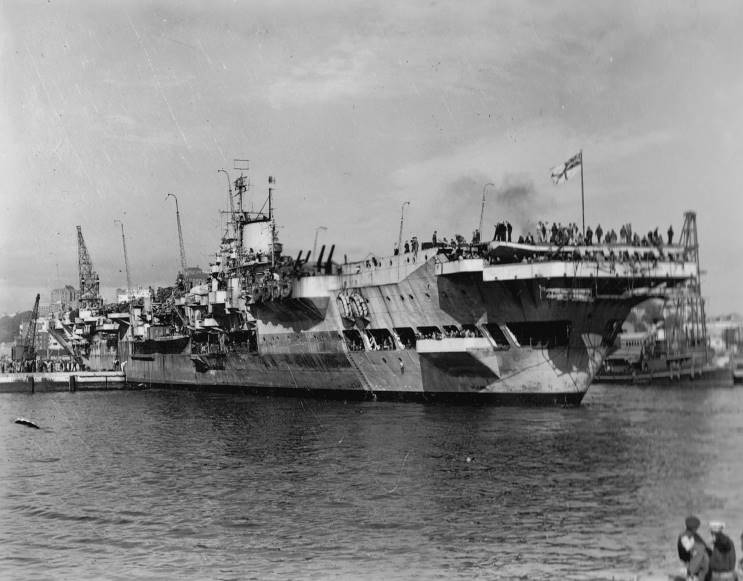HMS INDOMITABLE 12th AUGUST 1945 to 30th SEPTEMBER 1945
When the Japanese Emperor had
surrendered on 15th August the Senior British Government Official in
Stanley Prison Camp in Hong Kong was Franklin
Gimson. He had been the Colonial Secretary prior to the war. He went straight
to the Commandant of the Camp and told him that he would be taking over the
administration of Hong Kong and asked that they be provided with suitable
accommodation from which to run the colony. He also demanded that Japanese
troops continue to keep order there. The Commandant agreed. By 23rd official
word reached Gimson via Hong Kong Guerrilla forces that the UK Government also
wanted him to set up a government there. He got the old Chief Justice still in
the camp to swear him in. He was therefore Governor of Hong Kong before The BPF
arrived in Hong Kong .
On 27th August the Fleet
left Subic Bay and now the Task Group 111.2
consisted of aircraft carriers Indomitable and Vengeance, cruisers Euryalus,
Swiftsure, Black Prince, and RCN A/A cruiser Prince Robert, destroyers
Kempenfelt, Ursa, Quadrant and Whirlwind. There were eight RAN corvettes,
Mildura, Castlemaine, Bathurst ,
Broome, Freemantle, Strahan, Wagga and Stawell.
There was the 8th Submarine Flotilla and depot ship Maidstone . There were several minesweepers of the
Australian Navy that were to clear the channels ahead of the main force. When
they arrived at a position off the Islands
they were also met by the battleship Anson and aircraft carrier Vengeance. The
Fleet waited about twelve miles off shore, around Kam Tan Island
At 1200 on 30th August
1945 the Fleet assembled and as word had been received of possible suicide
attacks by explosive motor boats, all the ships were at Action Station and
commenced their passage into Hong
Kong Harbour Lamma Island
Dad has a copy of a signal from
the Commander of the Task Group 111.2, Rear Admiral Harcourt, at 1510Z on 30th
August, stating that;
2. ‘A
large number of suicide boats were observed in Picnic Bay. Three of these were
seen to leave the bay and attacked by aircraft with score of one sunk, one
beached and one returned to harbour. These boats were then well bombed and most
of them are now ashore.
3.
Venerable is remaining at sea for
the present and keeping continuous air patrol over Hong Kong.
4.
Japanese appear quite docile and
Chinese populace are beginning to handle them rather roughly. Japanese state
they have no mail from Japan for six months.
5.
Am meeting Japanese Commander
tomorrow to discuss arrangements for maintaining law and order and eventual
surrender.
6.
Gimson and Administration Council
appear to have the situation well in hand except for the ability to maintain
law and order and the shortage of supplies. Japanese are still endeavouring to
remove food and other stores but this is being stopped.
7.
This afternoon I visited all the
Prisoner of War and Internment camps and also British Hospitals. We received a
tumultuous welcome and it was magnificent to see the high state of morale
despite the obvious effects of malnutrition. Altogether a most moving
afternoon.
8.
Hope to start transference of
patients to Hospital Ship Oxfordshire tomorrow.’
The Explosive Motor Boats EMB’s
were called Shinyo by the Japanese which meant ‘Sea Quake’. They were suicide
boats in essence. The first few were built of steel but in 1944 the shortage of
materials meant they were all wooden from then. The Type 1 was an 18m single
man boat. They were capable of 23kts, which is not that fast and the speed
reduced to 18kts when the warhead was loaded in the bow. The idea was that they
directed the boat to the target and either jumped at the last minute or drove
it straight in to the target.
Shinyo Type 1 Explosive Motor Boat (EMB).
The Type 5 boat was two man and
fitted with twin automobile engines and 13.2 heavy machine guns and RT radio.
They were used as command vessels. Both Type 1 and 5 were fitted with two 120mm
rockets. These were intended to increase the speed of the boat on the final run
in and to give some power if the main engine(s) should fail. Approximately 6200
were constructed. Most were retained for use in the defence of the homeland but
of those sent abroad most went to the Philippines
and Okinawa . The ‘pilots’ were mainly flying
cadets about 17 years old. As the war had progressed there were no aircraft for
them to fly so 400 of them were transferred. They were given the choice to
train for conventional torpedo boats, special attack boats (Shinyo’s) or to be
suicide frogmen. About 150 chose to train for the Shinyo. The official three
month course for them started in October/November 1944. The Imperial Japanese
Navy hoped that a success rate of 10% was a good target. In effect they did not
achieve close to this rate. They claimed a handful of landing craft sunk and
damaged and no major assets were lost to them.
Type 5 Shinyo EMB.
On the 30th August Sub Lieutenant
Awamura of the 35th Special Attack Shinyo Squadron based on Lamma
Island set out from there to the travel to the Imperial Japanese Navy HQ to
inform them that all the warheads had been removed form the EMB’s. The only
transport available was one of the attack boats, minus it explosives. He was
spotted crossing the channel and this sparked the alert. The Sub Lieutenant’s
boat was destroyed and the base was put out of action for good.







